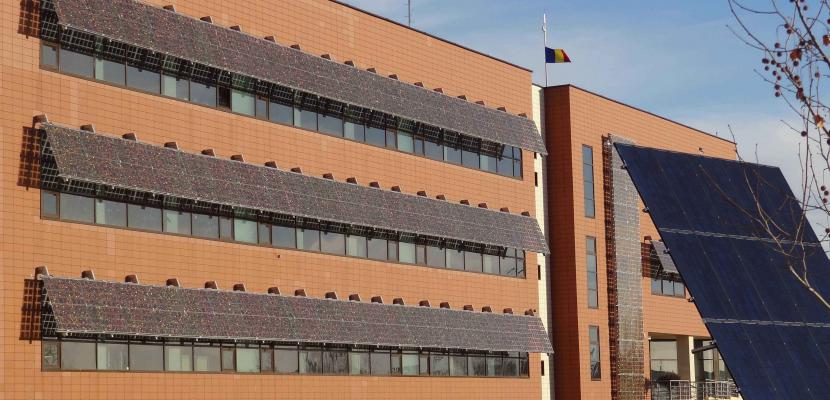
Microgrid coupled with BIPV and storage - integrated with EMS

About this good practice
Problems addressed:
1. Energy security due to poor grid in the area (energy quality and stability is essential for research activities, sensitive laboratory high-tech equipment’s and IT&C);
2. Building decarbonisation, an important >40% of energy usage is covered by PV all year long.
The systems were designed by PhD Dorin Let (senior researcher at ICSTM-UVT) and started operation in Feb. 2016.
The building’s energy system is complemented by a roof-top PV system designed to cover additional auxiliary large loads (HVAC, clean rooms, NO2 and O2 generators, chemical waters neutralisation station, ultra-pure water station, a.o.). The roof-top PV is comprised of mono & poly silicon and CdTe thin-film modules fix mounted at 30 degrees with 33kWp installed power coupled with on-grid inverters.
Results obtained: The microgrid system successfully protects from grid outages up to 2 hours in bad weather conditions and during entire daylight if cloud coverage is no more than 50%. On a seasonal basis, the average daily amount of PV production is 200kWh with 400kWh consumption (or 1.5MWh when chiller is in use). Due to PV arrays orientation (rooftop peak power in summertime and façade peak power during winter), the building consumption is constantly supplied by PV with battery backup for cloudy days and reserve power kept for blackouts.
Main stakeholders and beneficiaries: Institute’s researchers and the University administrative body.
Resources needed
Prerequisites: electrical cabinet with circuit branches and large loads circuits, operational PV and Storage systems, smart meters, Industrial grade EMS
Equipment: programable controllers (PLCs), sensors, transducers, communication interfaces, smart meters or power quality analysers, EMS software
Evidence of success
Operating in Microgrid configuration with constant load (IT infrastructure) the system demonstrated full autonomy (operating disconnected from the grid) during less than 40% cloud coverage periods, and up to 3 days of over 60% cloud coverage. The 2020 overhaul was designed to expand system capabilities (battery aggregation and technology shift to lithium) thus, it nowadays supports all activity loads except large building installations (non-critical).
Potential for learning or transfer
Energy security along with decarbonisation are the primary focus of EU Energy policy. Local PV generation coupled with storage provide the answer to both problems.
Considering the energy market volatility an investment in such a system makes strategic and economic sense. To achieve system expected operation a careful iterative process is recommended, the technical solution should be tailored by season and the load particularities. Building integrated and/or attached PV can be coupled with storage for excess generation own usage. Energy storage can use different vectors, batteries for electricity and/or hot water storage for thermal HVAC input.
Policies in the field of energy supply should promote autonomous and self-contained systems (microgrids) for key loads/facilities. Such policies could expand to new large office buildings. Local renewable energy generation and storage can be harnessed in existing and future buildings for a safer and sustainable energy supply solution.
Further information
Good practice owner
You can contact the good practice owner below for more detailed information.